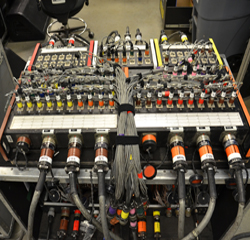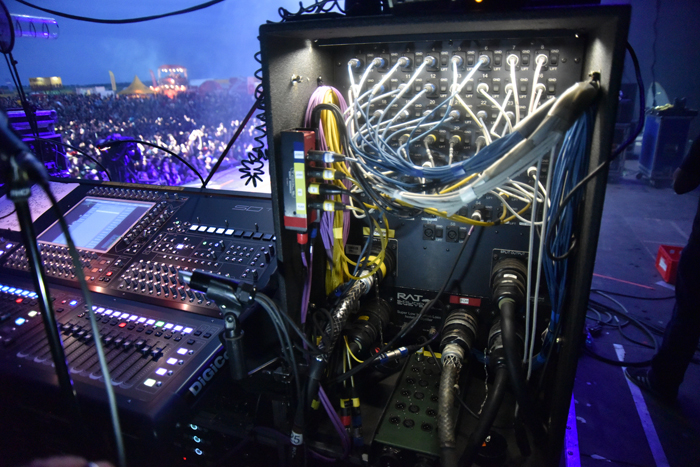
On The Road
Beyond Monterey, I checked in with several other touring companies to learn how they handle signal splitting for live events, especially when multiple splits are required for broadcast, recording, or similar applications.
In most cases, an “old-school” analog splitter with transformer-isolated outputs is the rule on the road (at least among those I spoke with), rather than sharing a common digital signal among the various applications.
Dave Skaff, senior tour support for Clair Global (Lititz, PA), says that “There seems to be two distinct camps between the live world of traveling music and broadcast. The live mixers are very ingrained with having their own head amp control. To give them that control, a digital split is kind of ruled out.”
A downside is that each console position needs its own stage racks with an analog split. Continuing, he adds, “In the broadcast world, the idea of using one set of head amps, and having several people follow with digital trim or some kind of gain tracking is a fairly accepted way of doing things – their comfort level is higher.”
On a recent U2 tour, Skaff notes, “We did entertain the idea of having digital splits, with certain people having control of stage racks and others using digital trim for levels.” During the planning, he adds that there were incidents where, if the digital loop went down, “you lost a lot of control.” The show was especially complex, with six different consoles that would be on the loop – FOH plus a backup, and three separate monitor setups with a backup.
Skaff notes that some of the tour staff’s fear of relying on the newer technology came from second-hand conversations they’ve “heard from others,” plus Clair’s own observations of small glitches that persuaded them to stay with the tried-and-true methods.
The company went back to a custom-designed 6-way analog splitter for the U2 shows so that each console would have control over levels, with proper loading for six mic preamps per channel and transformers that accept a wide range of signal levels without saturation. There were also conventional splitters that facilitate 3- or 4-way passive splits.
For a show that also needs to accommodate broadcast trucks, the engineer might ask for an isolated analog split or a digital split sent to them as AES3, or possibly a MADI split off the stage racks; Skaff has had all of the above requested recently. Many tours will provide an open analog split, available for a recording truck or other production application.
Smaller Or Larger Flexibility
Dave Rat of Rat Sound Systems (Oxnard, CA) discussed with me a “baseline method” of signal splitting, using a custom-built XLR panel with two 56-pair Whirlwind W4 MASS connector outputs. For smaller shows, the choice is usually a single panel for FOH and monitors, while for larger shows or ones that require separate recording or broadcast feeds, the approach is multiple panels with a single input and a pair of ISO outputs – with the direct signal going to FOH.

Rat Sound has also designed multi-connector panels that are fed from stage boxes, and by changing the tails, the switch between opening and headlining acts can be accomplished more quickly and reliably. Occasionally there are bands where both the FOH and monitor engineer are working with the same mixing console, and each will use a common digital split; any additional feeds for a production truck are likely to come from the analog splitter.
